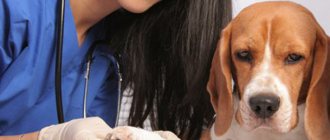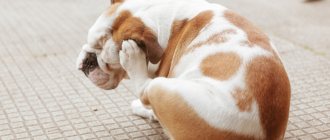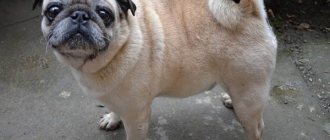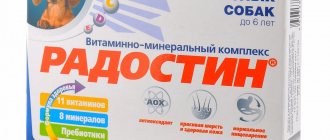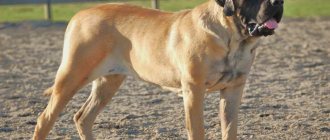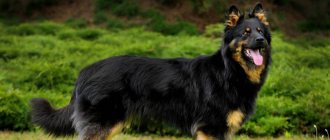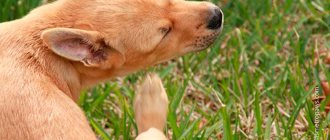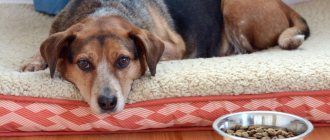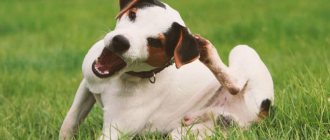How to understand that an animal is losing weight
They try to keep working (hunting) dogs in shape.
For some breeds, thinness is a distinctive feature, so it is not always possible to immediately notice the first signs of weight loss.
The following symptoms will indicate that your pet is having problems:
If a dog's ribs are palpable (although they are not visible through the skin), this is the first sign that the animal has begun to lose weight. However, it may still be in relatively normal physical shape.- If you notice protruding pelvic bones, you need to sound the alarm. This is a dangerous sign indicating health problems.
- If the dog has turned from an energetic dog into a lethargic, apathetic one, it means that it needs to be examined, and weight control must be carried out.
- Wool is an ideal indicator of an animal's condition. As weight decreases, the cover becomes dull. The bristles not only begin to fall out, but the pet becomes bald in places.
A dog that is losing weight can be not only lethargic, but also pathologically irritable. With a sharp decrease in weight, the animal develops shortness of breath, chills, and a rise in temperature. Frequent, profuse vomiting is possible.
The dog is losing weight: what are the reasons?
Their thinness is natural. In this case, it is very difficult to change anything, but you cannot leave the animal. The real owner always fights for his life to the last. We are talking about such serious diseases as hepatitis and adenovirus, which are always accompanied by changes in body weight. As a rule, such ailments require extensive treatment. Against the background of severe intoxication of the body, the pet can lose significant weight. For this reason, it is always recommended to seek help from a veterinary clinic.
Viral diseases are life-threatening for animals. They cannot be neglected or pretended that nothing is happening. The owner must mobilize his strength as much as possible and help the pet recover to the required level. In some cases, lack of weight does not indicate a pathology in the body, but the normal condition of the animal.
Tall, thin dogs can have enviable health. A person who understands these issues will definitely be able to tell the difference. It is worth remembering that some dog breeds naturally have a lightweight exterior.
Our articles on the Yandex main page
These include: Greyhound, Dalmatian, Chinese Crested, Great Dane, Italian Greyhound. These animals are never well-fed, no matter how they are fed. Their elegance looks quite graceful. Only in this case can a long, thin dog look beautiful. Owners of dogs of these breeds should not force-feed their pets. The owner of the animal, noticing thinness, must begin to take certain steps. If this is not done, then at some point you may be left without a four-legged friend.
If we are not talking about specific breeds of long, thin dogs, you need to analyze your care for the animal and draw the appropriate conclusions. It is known that a dog should not be fed food from the table.
Causes of pet exhaustion
The dog eats well, but at the same time loses weight, often due to improper nutrition. This can be caused by various factors:
The animal’s food needs have increased, and they are associated with the following points:- the pet is too active and wastes energy on movements;
- pregnant and lactating dogs require increased nutrition;
- The puppy is growing quickly and needs high-calorie food.
- Low-calorie food.
- Unbalanced diet and lack of calories, but the dog has a good appetite and eats a lot.
- A sudden transfer to a different diet: the dog may begin to lose weight due to stress or even refuse unusual food.
- Extreme heat: The dog eats less well, but drinks a lot of water and can still remain active.
Dietary problems can be easily fixed. But if, after adjusting the diet, the owner notices that the dog continues to lose weight, one should look for internal reasons.
Why does a dog lose weight?
| Factors | Description |
| Gastrointestinal diseases | Poor quality nutrition can provoke the development of gastritis, pancreatitis, colitis, and stomach ulcers. |
| Infestations | Even with a balanced diet, sudden weight loss is observed if helminths have settled in the body. Their presence can lead to volvulus. In this case, the dog does not eat anything, and its belly is large |
| Wounds in the mouth | If your pet doesn’t eat well or refuses food and drinks a lot of water, you should look into its mouth; it may have broken teeth, damaged palate or larynx. |
| Ear problems | Infectious diseases affecting the hearing aid make chewing difficult |
| Viruses | The animal may become ill with adenovirus or hepatitis. To exclude these diagnoses, any rapid weight loss in your pet should be examined. |
| Allergy | Both harmful environmental elements and an allergic reaction to new products can lead to the problem. |
| Oncology | Sudden weight loss with refusal to eat may be a sign of the development of cancerous tumors |
Sometimes dogs end up on the operating table, and after anesthesia have difficulty returning to their usual diet. This situation is considered normal if it lasts 2-3 days.
Stable dynamics of weight loss lasting more than five days should alert you. Perhaps the surgical intervention disrupted some processes in the body.
If a dog has gone on a hunger strike and is wasting away before our eyes, it should be taken to the veterinarian immediately. An animal that is not vaccinated in a timely manner can develop a dangerous disease – distemper.
Why does a dog lose weight quickly?
What should an owner pay attention to first if their dog is eating but losing weight? First of all, you need to look into his mouth, assess the condition of his teeth, tissues of the palate, pharynx, and gums. If their color has not changed, there is no plaque or inflamed areas, you can proceed to examination and palpation of the peritoneum.
Unintentional weight loss can be associated with a number of pathological conditions.
Gastrointestinal diseases
Normally, the dog's stomach remains soft if you gently press on it. If the abdominal muscles tense when touched, this may be a sign of illness. This is observed with inflammation of the stomach, the presence of a foreign object in this organ, ulcerative damage to the walls, intestinal blockage and other pathologies of the gastrointestinal tract.
With diseases of the gastrointestinal tract, the dog develops diarrhea, he becomes lethargic, apathetic, and suffers from vomiting. If any of the symptoms occur, it is recommended to measure the pet’s temperature and assess the condition of the mucous membranes - their blue or yellow discoloration is a serious symptom of the disease.
Almost any disease associated with disruption of the gastrointestinal tract is accompanied by pain of a different nature. You can usually tell that a pet is in pain by its reactions. If the dog is trembling, irritated, acting cautiously, and his breathing is shallow, we are talking about severe pain. In this case, the dog, when standing, begins to hunch his back, and his steps are small, without scope.
Ears or teeth hurt
If a dog is bothered by a toothache or earache, it refuses to eat. In such cases, the problem can be identified by pressing on the base of the ears - a sharp reaction from the pet will confirm that this is where the inflammation is localized. It is important to seek help from a veterinarian immediately.
Allergic reactions
Food allergies are another reason why your dog eats and loses weight. With this pathology, the animal’s body begins to function in emergency mode, which leads to increased energy consumption and a decrease in body weight.
This condition is accompanied by certain signs: the dog begins to actively itch, the flow from the eyes and nose intensifies, and the appetite worsens. Irritated areas may appear on the skin, and hair may fall out in places.
If during the initial examination it was not possible to detect parasites that can cause such symptoms, you should give your pet an antihistamine. If the symptoms begin to subside, then it is still an allergy problem.
Worm infestations
Worms are frequent guests of the dog’s body, eating what is intended for the normal functioning of the animal’s organs and systems. In this case, the dog eats with increased appetite, but important substances are provided not by it, but by its “neighbors.”
There is a schedule for deworming dogs, according to which pets are given anthelmintic drugs, usually this event is carried out once every 3-4 months. If you follow this rule, the helminths that have entered the body will not have time to actively multiply and cause serious harm.
If the owner forgets about the procedure or ignores it completely, the worms can spread throughout all systems, consuming vital components before they are digested and absorbed into the intestines. Some of the worms can seriously damage the tissues of the liver, lungs, heart and even brain. And if this happens, you can expect serious changes, including metabolic disorders.
In such a situation, the pet sharply loses weight, lacks vitamin components and microelements, and organ failure develops. Such conditions often lead to irreversible consequences and death of the dog.
Contacting a veterinarian will help save your pet’s life, but the consequences of helminthic infestation can subsequently cause various complications and periodically remind themselves. So it is better to take care of prevention; this will not 100% protect the dog from worms, but it will reduce the likelihood of them staying comfortably in the pet’s body.
Postoperative recovery
Any surgical intervention, even minimally invasive, is stressful for the animal’s body, and weight loss during this period is considered normal. But, of course, we are not talking about critical weight loss, when only “skin and bones” remain from a well-fed pet.
Unfortunately, four-legged friends tolerate anesthesia worse than humans. This applies even to physically strong, young animals, but they have enough internal reserves to recover. Much depends on how complex the operation turned out to be, and during this period it is important that the pet is monitored by a specialist.
If a dog is losing more weight than expected, an experienced doctor will definitely pay attention to this fact. If he does not consider this sign dangerous, it is worth consulting with another veterinarian.
Viral infections
Viruses are very dangerous for dogs, regardless of the age and breed of the animal. The risk group includes puppies and older dogs. A sharp decrease in body weight can be caused by any viral pathogen, but vaccination can protect against some of them:
- rabies - the disease is dangerous for humans, but fatal for dogs;
- carnivore plague - can be cured only at an early stage of development;
- enteritis – even vaccination will not protect your pet 100%, but will help avoid acute manifestations of the disease;
- adenovirus – rarely detected, requires serious, long-term treatment;
- leptospirosis - the disease is dangerous for people, treatable, rarely diagnosed;
- piroplasmosis – with the help of a vaccine it is possible to avoid acute manifestations of the disease.
Oncological processes
Malignant formations and metastases also lead to a sharp weight loss in the animal. The danger lies in the fact that in most cases it is possible to identify the disease only in the later stages. The initial stages of cancer are latent, without pronounced symptoms, so they are often discovered during diagnostics not related to oncology.
Late stage cancer is not curable, but stops. The animal is prescribed a course of chemotherapy or radiation therapy. These methods are quite harsh, they harm not only malignant cells, but also healthy ones, so the dog loses weight and feels unwell, both during treatment and after it. With the help of competent restorative therapy, it is possible to restore the dog’s strength and appetite.
What to do if your dog is losing weight for no reason
It is not always possible to determine the true cause of weight loss. But measures must be taken as soon as the first warning signs are discovered. They start by studying everyday nuances.
Pet diet
Review the animal's menu.
It must correspond to the dog’s size, age, gender, physiological characteristics, and level of activity. You need a varied, healthy and balanced diet of carbohydrates, proteins, and fats .
A menu that does not meet these requirements must be rebuilt.
But if this does not help, and the pet continues to lose weight, you need to go to the veterinarian.
Survey
At the hospital, the doctor first examines the dog visually, looks into the mouth, palpates the throat, peritoneum, etc. If the presence of diseases is suspected, laboratory tests are prescribed. An ultrasound may be needed. This will allow you to find the reason why the dog began to lose weight.
After making a diagnosis, the doctor selects treatment on an individual basis.
How to perform an inspection
- You need to start from the head, from the eyes. Normally, the organs of vision are clear, without discharge, the conjunctiva is pale pink, the pupils are identical, they react to light, the cornea is moist, not dry, and shiny. Move on to the ears. A small amount of sulfur and dust is acceptable; a gray or black coating should alert you. There should be no unpleasant odor from the ears. If you squeeze the ear at the base, an unfavorable symptom will be a squelching sound and pain. Examine your nose. Smell the air your dog is exhaling. Make sure both nostrils are working: bring the back of your hand to your nose.
- Move to the mouth. Disorders in the oral cavity often lead to refusal to eat. For example, if a foreign body or a piece of wood is stuck in the mouth, pets often chew sticks. Lift your lip, inspect your gums and teeth, and carefully open your mouth. It is sometimes possible to find pieces of food and foreign bodies between the teeth; often the objects are easy to remove on your own, which will bring great relief to the animal. Teeth should be white and shiny. Pigment spots are allowed on the tongue and palate; pimples and ulcers signal trouble; take your dog to the doctor.
- Go down from the head to the neck, move to the torso. Look for tangles, wounds, baldness, attached ticks and other parasites, and pay attention to any abnormalities. Examine the anus. There should be no sticking feces visible, the anus should not bulge or appear red. The abdomen is soft, painless, not tense, not bloated. If the animal is in pain when pressure is applied to the stomach, the animal bends over, tucks its tail, and is capable of whining and squealing if the pain is severe. Examine and palpate the mammary glands. Examine the groin and genitals for redness, inflammation, and unusual discharge.
- Paws require special attention. If an animal hurts its paw, it causes severe suffering. Inspect the pads, the spaces between the toes, where sharp wood chips or mown grass can stick. Check the condition of the claws.
If you notice any changes in your pet's health, contact your veterinarian. Additionally, before visiting the doctor, measure your dog’s temperature.
Dog feeding rules
An animal that has lost weight requires increased nutrition. You need to make sure that the dog’s body receives the required amount of minerals and vitamins.
When solving the problem of how to gain weight for a pet, they use 2 options: increase the volume of food or its calorie content.
At the same time, you need to make sure that the dog does not overeat, otherwise digestive problems will begin.
The increase in the volume of food occurs gradually, and the dog is transferred to split 3-5 meals a day with meals at the same hours.
When caring for a dog, the owner must follow the following feeding rules:
- The amount of food is selected based on physical activity: the daily intake of an active dog should be greater than what a phlegmatic pet receives.
- It is necessary to monitor the dog after feeding: if it is full, it will immediately leave the place where the bowl is, otherwise the animal will continue to lick the empty container and move it from place to place. If this is not ordinary greed, then the pet’s request must be satisfied by adding food.
A healthy dog is fed 2 times a day, and a dog on a diet increases the number of meals, but in any case, the plate is removed 20 minutes after the start of feeding (even if there is food left in it).- When the animal receives dry food, it is necessary to place a bowl of clean water nearby.
If the basic rules of feeding are followed, and the pet is losing weight for no reason, you should discuss the diet with a veterinarian and conduct an additional examination.
Calculation of the balance of vitamins and minerals
When a pet's diet contains industrial food, the body receives useful elements if the products are selected correctly and given to the dog in the right quantity.
With a random or limited set of products, the animal does not receive enough minerals and vitamins, which is why health problems begin.
It is important to immediately set up a balanced diet that contains glycerophosphate, calcium, bone meal, etc. But it should be borne in mind that an overdose of microelements is no less dangerous than their deficiency.
To maintain the balance of nutrients, you will need a veterinarian's recommendation.
It will be difficult to independently calculate and select the dosage, because it is necessary to take into account many factors: breed, weight, dimensions, age, health status, pregnancy and lactation.
How and what to feed a losing weight dog
A dog that has lost significant weight is gradually returned to a normal diet, first by slightly limiting the animal’s activity. In this case, the following rules are adhered to:
- if the dog eats natural products, then the diet must include porridge and light soups;
It is recommended to flavor raw vegetables with vegetable oil or low-fat sour cream - this promotes better absorption of vitamins;- even an animal on dry food should be periodically given raw meat (excluding lamb and pork), but it must first be doused with boiling water to avoid infection with helminths;
- Boiled fish fillets are added to the menu 1-2 times a week.
To pamper your pet with a treat, give him a “sugar” bone to chew on as a snack. But foods high in carbohydrates (baked goods, sweets), spices, flavorings, smoked foods and fried foods should be excluded completely.
Milk is only good for babies; adult dogs have a low lactose tolerance.
